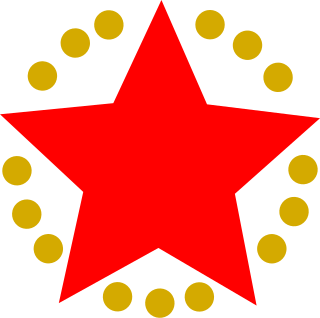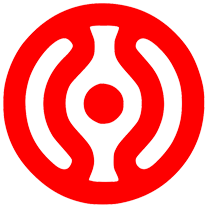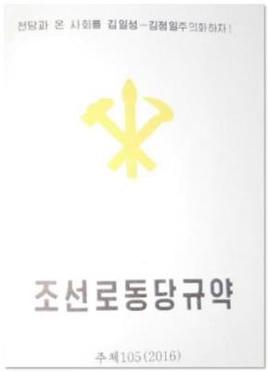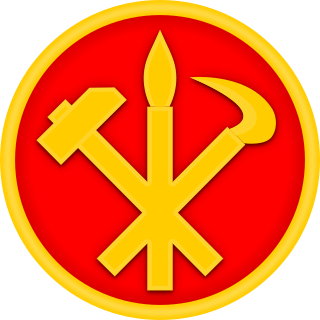
The politics of North Korea takes place within the framework of the official state philosophy, Kimilsungism-Kimjongilism. Juche, which is a part of Kimilsungism-Kimjongilism, is the belief that only through self-reliance and a strong independent state, can true socialism be achieved.

The Supreme People's Assembly is the legislature of North Korea. It is ostensibly the highest organ of state power and the only branch of government in North Korea, with all state organs subservient to it under the principle of unified power. However, in practice it is a rubber stamp legislature which exists to approve decisions made by the ruling party as a formality, and which has little to no real power of its own.

The Korean Social Democratic Party (KSDP) is a political party in North Korea that is allied with the ruling Workers' Party of Korea (WPK). It was formed on 3 November 1945 as the Korean Democratic Party by a mixed group of entrepreneurs, merchants, handicraftsmen, petite bourgeoisie, peasants, and Christians. The party's founders were motivated by anti-imperialist and anti-feudal aspirations, and aimed to eliminate the legacy of Japanese rule and build a new democratic society. The party came under greater influence of the ruling government over time, and today is under the effective control of the WPK.

The Chondoist Chongu Party (Korean: 천도교청우당) is a popular front party in North Korea. The party was founded on 8 February 1946 by a group of followers of the Ch'ŏndogyo. The party increasingly came under the influence of the government over time and is now under the effective control of the ruling Workers' Party of Korea. The founding-leader of the party was Kim Tarhyon.

Elections in North Korea are held every four-to-five years for the Supreme People's Assembly (SPA), the country's national legislature, and every four years for Local People's Assemblies. Critics argue that North Korean elections are show elections which lack competition and allow the government to claim a veneer of legitimacy, with all candidates preselected and no option to write in other candidates. According to official reports, turnout is near 100%.

The General Federation of Trade Unions of Korea is the sole legal trade union federation in North Korea. GFTUK was formed on November 30, 1945 as the General Federation of Trade Unions of North Korea. In January 1951, it was reorganized and adopted its current name. The chairman of the central committee of GFTUK is Pak In-chol.

The Workers' Party of North Korea was a communist party in North Korea from 1946 to 1949 and was a predecessor of the current Workers' Party of Korea. It was founded at a congress on 28–30 August 1946, by the merger of the northern branch of the Communist Party of Korea and the New People's Party of Korea. Kim Tu-bong, the leader of the New People's Party, was elected chairman of the party, while Chu Yong-ha and Kim Il Sung were elected as vice chairmen. At the time of establishment, the party is believed to have had about 366,000 members organized in around 12,000 party cells.

The Communist Party of Korea was a communist party in Korea. It was founded during a secret meeting in Seoul in 1925. The Governor-General of Korea had banned communist and socialist parties under the Peace Preservation Law, so the party had to operate in a clandestine manner. The leaders of the party were Kim Yong-bom and Pak Hon-yong.
The Communist movement in Korea emerged as a political movement in the early 20th century. Although the movement had a minor role in pre-war politics, the division between the communist North Korea and the anti-communist South Korea came to dominate Korean political life in the post-World War II era. North Korea, officially the Democratic People's Republic of Korea, continues to be a Jucheist state under the rule of the Workers' Party of Korea. In South Korea, the National Security Law has been used to criminalize advocacy of communism and groups suspected of alignment with North Korea. Due to the end of economic aid from the Soviet Union after its dissolution in 1991, due to the impractical ideological application of Stalinist policies in North Korea over years of economic slowdown in the 1980s and receding during the 1990s, North Korea continues to nominally uphold Communism, but has replaced Marxism-Leninism with the Juche idea. References to Communism were removed in the North Korean 1992 and 1998 constitutional revisions to make way for the personality cult of Kim's family dictatorship and the North Korean market economy reform. The Workers' Party of Korea under the leadership of Kim Jong Un later reconfirmed commitment to the establishment of a communist society, but orthodox Marxism has since been largely tabled in favor of "Socialism in our style". Officially, the DPRK still retains a command economy with complete state control of industry and agriculture. North Korea maintains collectivized farms and state-funded education and healthcare.

The Workers' Party of Korea (WPK) is the sole ruling party of the Democratic People's Republic of Korea, commonly known as North Korea. Founded in 1949 from a merger between the Workers' Party of North Korea and the Workers' Party of South Korea, the WPK is the oldest active party in Korea. It also controls the Korean People's Army, North Korea's armed forces. The WPK is the largest party represented in the Supreme People's Assembly and coexists with two other legal parties that are completely subservient to the WPK and must accept the WPK's "leading role" as a condition of their existence. The WPK is banned in the Republic of Korea under the National Security Act and is sanctioned by the United Nations, the European Union, Australia, and the United States.

The Arch of Reunification, officially the Monument to the Three-Point Charter for National Reunification, was a sculptural arch located south of Pyongyang, the capital of North Korea. It was opened in August 2001 to commemorate Korean reunification proposals put forward by Kim Il Sung. Made of concrete, the arch straddled the multi-laned Reunification Highway leading from Pyongyang to the Korean Demilitarized Zone. The arch appeared on postage stamps issued in 2002, 2015, 2016, and 2021. The monument was demolished in January 2024.

Kim Il was a North Korean politician who was served as Premier of North Korea from 28 December 1972 to 19 April 1976.
Kang Kwan-ju, or Kang Chu Il, is a North Korean politician. He is head of department 225 of the Cabinet of North Korea, and an alternative member of the 6th Central Committee of the Workers' Party of Korea. He is the vice-chair of the Committee for the Peaceful Reunification of the Fatherland.

The Rules of the Workers' Party of Korea are the by-laws of the Workers' Party of Korea (WPK). It sets the rules of the organization and membership of the party. According to the rules, the WPK Congress is the highest body of the party and it, along with the WPK Conference, can amend the rules. The rules defines the character, task, and methodology of the party. According to it, the Party strives to impose communism on the whole of the Korean Peninsula. Recent revisions of the rules have defined Kimilsungism–Kimjongilism as the ideology of the party.

Pak Chong-ae, also known as Pak Den-ai, was a North Korean politician.

The Propaganda and Agitation Department, officially translated as the Publicity and Information Department, is a department of the Central Committee of the Workers' Party of Korea (WPK) tasked with coordinating the creation and dissemination of propaganda in North Korea. It is the highest propaganda organization in the country.

The United Front Department of the Workers' Party of Korea is a department of the Central Committee of the Workers' Party of Korea (WPK) tasked with relations with South Korea. It conducts propaganda operations and espionage and manages front organizations, including the Chongryon.
Parliamentary by-elections were held in North Korea on 19 July 1959 in 56 electoral districts. The reason for the by-election was an unusually high number of vacancies – more than a quarter of seats – in the Supreme People's Assembly.
Kim Tal-hyon was a North Korean politician and independence activist.





















